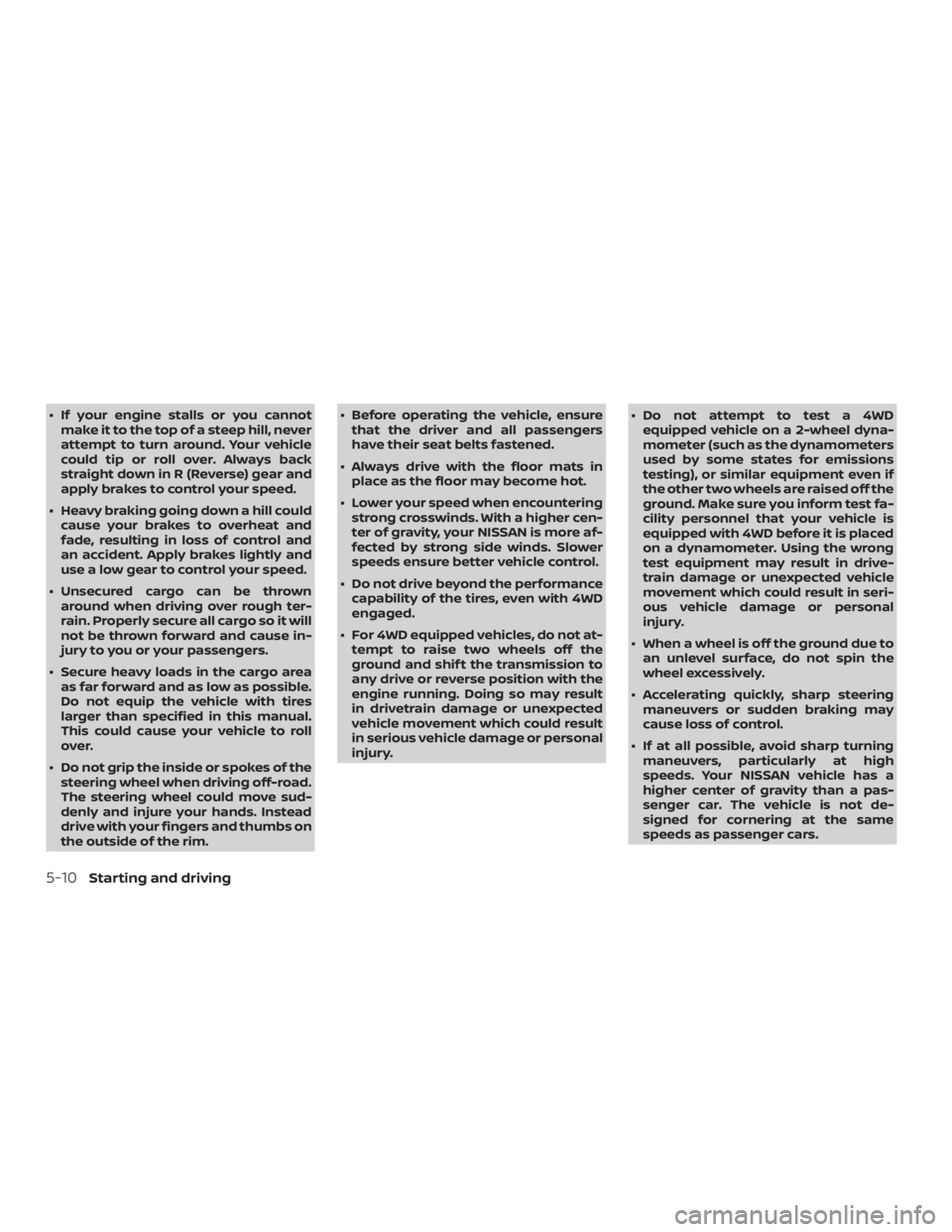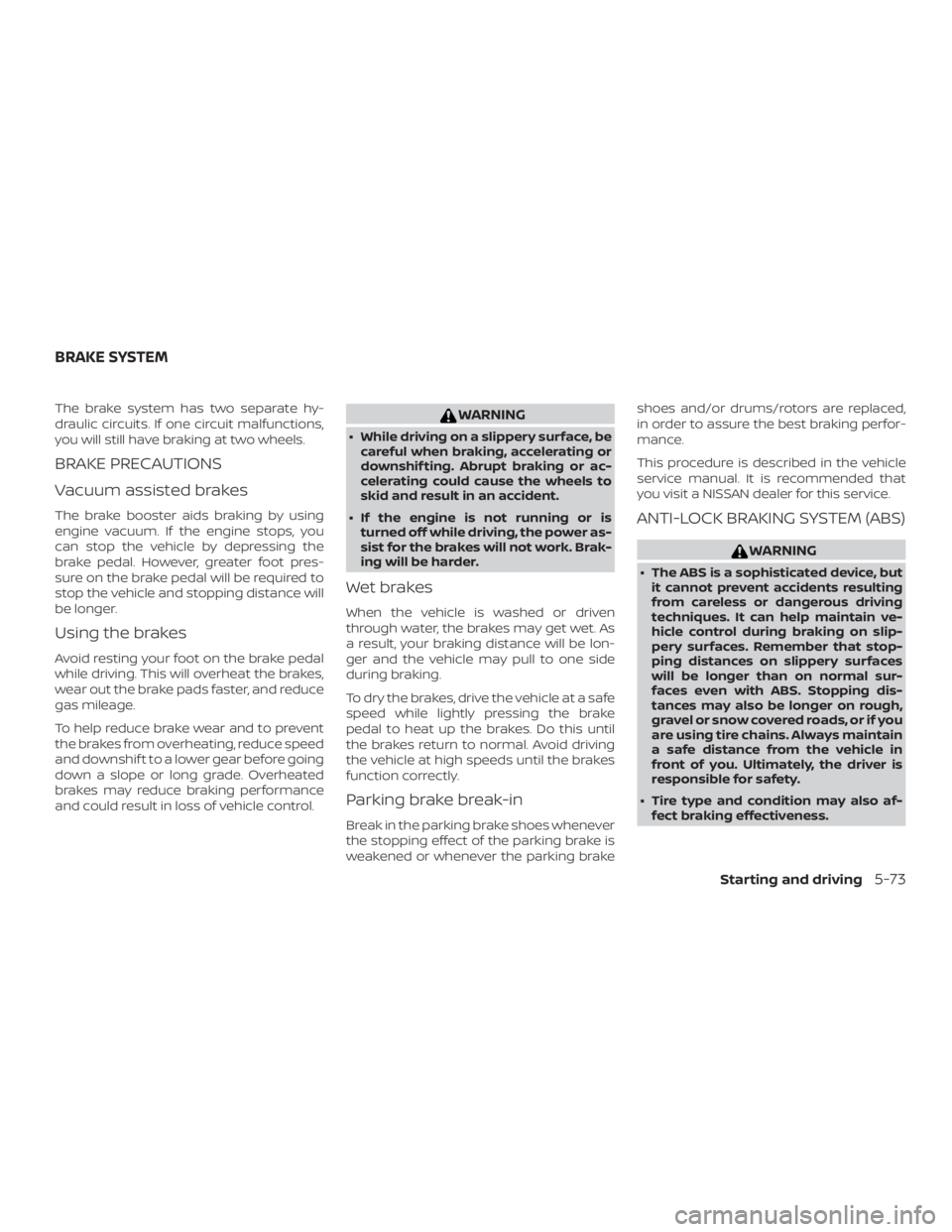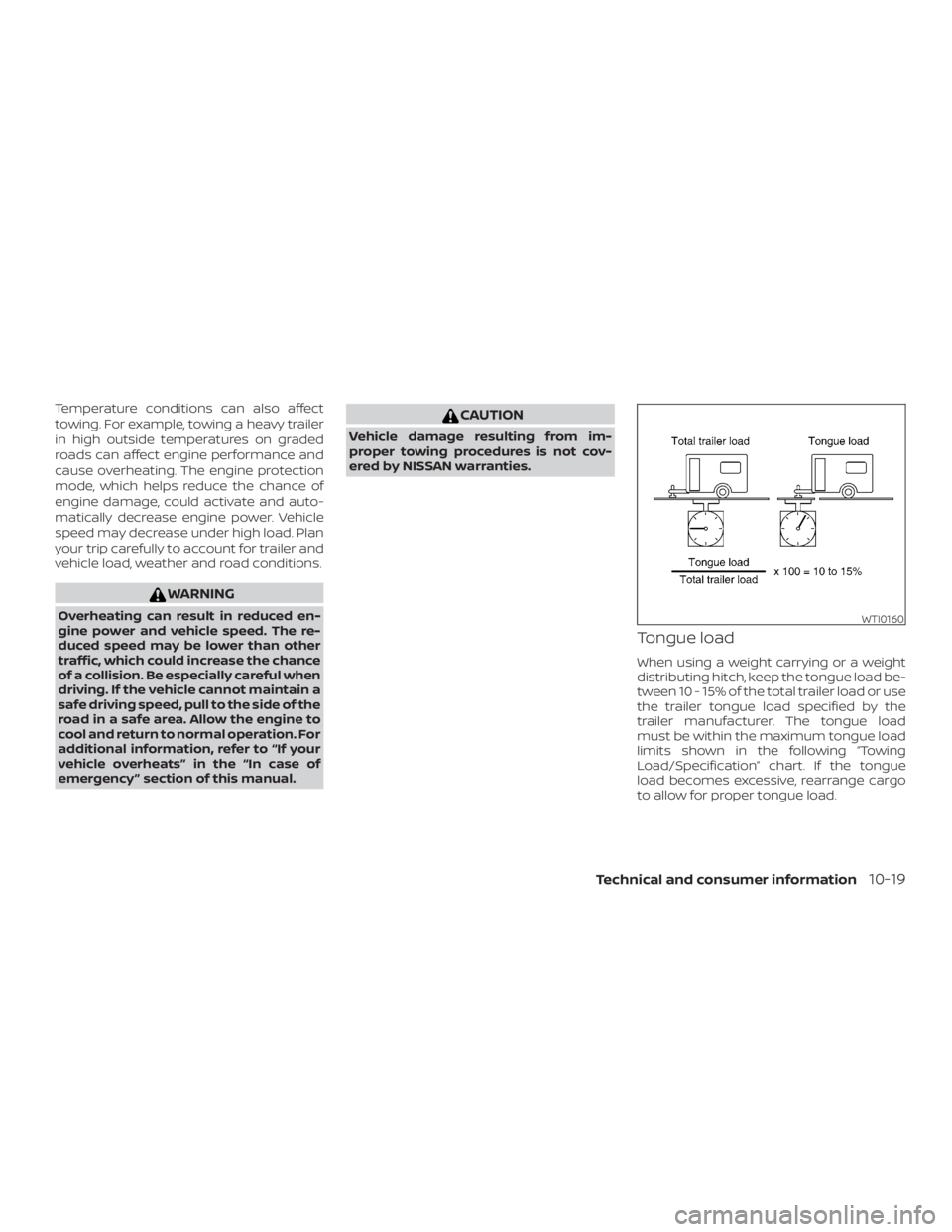2019 NISSAN PATHFINDER SV engine overheat
[x] Cancel search: engine overheatPage 278 of 476

∙ If your engine stalls or you cannotmake it to the top of a steep hill, never
attempt to turn around. Your vehicle
could tip or roll over. Always back
straight down in R (Reverse) gear and
apply brakes to control your speed.
∙ Heavy braking going down a hill could cause your brakes to overheat and
fade, resulting in loss of control and
an accident. Apply brakes lightly and
use a low gear to control your speed.
∙ Unsecured cargo can be thrown around when driving over rough ter-
rain. Properly secure all cargo so it will
not be thrown forward and cause in-
jury to you or your passengers.
∙ Secure heavy loads in the cargo area as far forward and as low as possible.
Do not equip the vehicle with tires
larger than specified in this manual.
This could cause your vehicle to roll
over.
∙ Do not grip the inside or spokes of the steering wheel when driving off-road.
The steering wheel could move sud-
denly and injure your hands. Instead
drive with your fingers and thumbs on
the outside of the rim. ∙ Before operating the vehicle, ensure
that the driver and all passengers
have their seat belts fastened.
∙ Always drive with the floor mats in place as the floor may become hot.
∙ Lower your speed when encountering strong crosswinds. With a higher cen-
ter of gravity, your NISSAN is more af-
fected by strong side winds. Slower
speeds ensure better vehicle control.
∙ Do not drive beyond the performance capability of the tires, even with 4WD
engaged.
∙ For 4WD equipped vehicles, do not at- tempt to raise two wheels off the
ground and shif t the transmission to
any drive or reverse position with the
engine running. Doing so may result
in drivetrain damage or unexpected
vehicle movement which could result
in serious vehicle damage or personal
injury. ∙ Do not attempt to test a 4WD
equipped vehicle on a 2-wheel dyna-
mometer (such as the dynamometers
used by some states for emissions
testing), or similar equipment even if
the other two wheels are raised off the
ground. Make sure you inform test fa-
cility personnel that your vehicle is
equipped with 4WD before it is placed
on a dynamometer. Using the wrong
test equipment may result in drive-
train damage or unexpected vehicle
movement which could result in seri-
ous vehicle damage or personal
injury.
∙ When a wheel is off the ground due to an unlevel surface, do not spin the
wheel excessively.
∙ Accelerating quickly, sharp steering maneuvers or sudden braking may
cause loss of control.
∙ If at all possible, avoid sharp turning maneuvers, particularly at high
speeds. Your NISSAN vehicle has a
higher center of gravity than a pas-
senger car. The vehicle is not de-
signed for cornering at the same
speeds as passenger cars.
5-10Starting and driving
Page 341 of 476

The brake system has two separate hy-
draulic circuits. If one circuit malfunctions,
you will still have braking at two wheels.
BRAKE PRECAUTIONS
Vacuum assisted brakes
The brake booster aids braking by using
engine vacuum. If the engine stops, you
can stop the vehicle by depressing the
brake pedal. However, greater foot pres-
sure on the brake pedal will be required to
stop the vehicle and stopping distance will
be longer.
Using the brakes
Avoid resting your foot on the brake pedal
while driving. This will overheat the brakes,
wear out the brake pads faster, and reduce
gas mileage.
To help reduce brake wear and to prevent
the brakes from overheating, reduce speed
and downshif t to a lower gear before going
down a slope or long grade. Overheated
brakes may reduce braking performance
and could result in loss of vehicle control.
Page 449 of 476

Temperature conditions can also affect
towing. For example, towing a heavy trailer
in high outside temperatures on graded
roads can affect engine performance and
cause overheating. The engine protection
mode, which helps reduce the chance of
engine damage, could activate and auto-
matically decrease engine power. Vehicle
speed may decrease under high load. Plan
your trip carefully to account for trailer and
vehicle load, weather and road conditions.
Page 471 of 476

OilCapacities and recommended
fuel/lubricants...............10-2
Changing engine oil ............8-6
Changing engine oil filter .........8-6
Checking engine oil level .........8-6
Engine oil ...................8-6
Engine oil and oil filter
recommendation .............10-7
Engine oil viscosity .............10-7
Outsidemirrors ................3-47
Overhead sunglasses holder ........2-60
Overheat Ifyourvehicleoverheats.........6-12
Owner's manual order form ........10-35
Owner's manual/service manual order
information..................10-35
P
Parking Parking brake operation .........5-21
Parking/parkingonhills.........5-72
Parkingbrake..................5-21
Personal lights .................2-72
Power Front seat adjustment ...........1-5
Power door locks ............3-6,3-7
Poweroutlet.............2-54,2-55
Powerrearwindows...........2-66
Powersteeringfluid............8-10
Power steering system ..........5-72
Powerwindows..............2-65
Rearpowerwindows...........2-66
Powerinverterswitch ............2-52 Poweroutlet...............2-54,2-55
Powersteering.................5-72
Powersteeringfluid..............8-10
Precautions
Maintenance precautions .........8-2
On-pavement and off-road driving
precautions .................5-7
Precautions on booster
seats............1-30, 1-37, 1-43, 1-49
Precautions on child
restraints.........1-30, 1-37, 1-43, 1-49
Precautions on seat belt usage .....1-18
Precautions on supplemental restraint
system ................... .1-53
Precautions when starting and
driving.....................5-2
Push starting ..................6-12
R
Radio Car phone or CB radio ..........4-41
Readiness for inspection maintenance
(I/M) test ....................10-34
RearCrossTrafficAlert(RCTA) .......5-32
Rear Door Alert .............2-32,2-50
Rearpowerwindows.............2-66
Rear Sonar System (RSS) ...........5-79
Rearviewmirror................3-45
RearViewMonitor................4-3
Rear window and outside mirror defroster
switch......................2-38
Rear window wiper and washer
switches .....................2-37
Recommended Fluids ............10-2 Recorders
EventData.................10-34
Refrigerant recommendation ........10-8
Registering a vehicle in another
country .....................10-11
Remote Engine Start ..........3-29,5-16
Reporting safety defects (US only) . . . .10-33
Roofrack....................2-64
S
Safety Child safety rear door lock ........3-7
Childseatbelts......1-30, 1-37, 1-43, 1-49
Reporting safety defects (US only) . .10-33
Seat adjustment Front manual seat adjustment ......1-3
Front power seat adjustment ......1-5
Rear seat adjustment ...........1-7
Second row bench seats .........1-9
Seatback pockets ...............2-57
Se
at beltChildsafety................ .1-27
Infants and small children ........1-28
InjuredPerson............... .1-21
Largerchildren.............. .1-28
Precautionsonseatbeltusage.....1-18
Pregnant women ..............1-21
Seat belt extenders ............1-26
Seat belt maintenance ..........1-27
Seatbelts................1-18, 7-7
Three-pointtypewithretractor.....1-21
Seat belt extenders ..............1-26
Seatbeltwarninglight.........1-21, 2-15
11-5